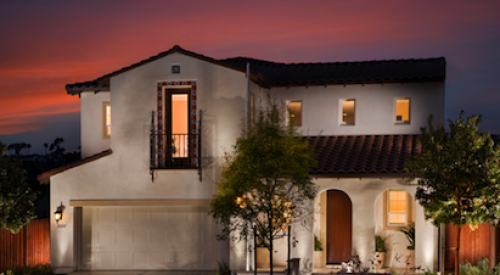| From top to bottom: Todd JohnstonÆs Augusta model, John CannonÆs Talia model, Bamboo Building & DevelopmentÆs Biscayne model.
|
When the biggest worry builders have is how to get houses built (rather than sold), you know times are good. And yet, there are problems. The skilled labor shortage is one they deal with every day. But thereÆs another that wakes them up at night: "Where will I get the land I need to compete?"
With lot supplies tightening in most markets, the temptation is there for builders to buy land and develop their own communities. But many of the builders considering that step have no experience in land development. And they all know that carrying land is the biggest risk in real estate.
Still, they also know the terms developers now require to build in their communities are so high that developing on their own is not necessarily cost prohibitive. "In a lot of cases, the developers are not just pushing lot prices, they are also requiring the builders to put up two furnished models where it used to be one," says management consultant Chuck Shinn, who sees builders wrestling with this issue all across the country. "TheyÆre asking the builders to take down 12 lots up front, instead of ten, and carry three specs instead of two. ThatÆs a lot of money up front. And a year later, the builders who take that deal may find themselves competing with eight other builders at the same price point, in the same basic location. Then they really start to wonder if developing land wouldnÆt be better despite the risk."
No wonder they wake up at night in a cold sweat.
However, there is a third option: three or four builders can go together to form a land partnership that buys and develops one site, or several. That helps all of them to re-establish some control over the essential raw material of the housing business. It also limits the competition at that particular location, and allows the builders to garner the margin in the lots for themselves.
The Sarasota Situation
Three high-end, semi-custom builders in Sarasota, Fla., John Cannon, Todd Johnston and Gary Roberts, decided to take that third option three years ago and are now reaping the benefits.
"At the time, I was real active in Turtle Rock, a planned unit development at Palmer Ranch (a 10,000-acre master planned community in central Sarasota County)," says John Cannon. "With build-out in sight on that one, I was looking for another location nearby, to capitalize on the market presence IÆd established.
"The problem was, Palmer Ranch decided it no longer wanted to develop residential land. The owner, Hugh Culverhouse Jr., was talking about selling off development pods or even the whole Ranch. With so many national builders coming into the Sarasota market at the time, that was a real concern."
Cannon spoke to Culverhouse about available sites, thinking at first that he might try something on his own. Culverhouse pointed Cannon toward the 223-acre pod that is now Silver Oak. "I liked the idea and the land section, but 223 acres was more than I wanted to try by myself," says Cannon.
At the time, Cannon was also president of the Sarasota HBA. In a local pub, after an HBA meeting, he broached the subject with Todd Johnston, a friend, but also a competitor. Johnston builds just over 100 houses a year, Cannon about 75, and both average about $500,000 per sale (excluding land). Johnston has eight model home presentations in master planned communities around the area, Cannon seven.
"All the local builders had been talking for some time about ways to compete with the big national builders coming into the market," says Johnston. "John and I agreed to see if we could put together a consortium to go after Silver Oak."
It was a perfect deal for a new land partnership. While Silver Oak required subdividing and development of roads and lots, the zoning, entitlements and even engineering was already in place. "If weÆd had to do a land assembly and take the site through the entitlement process, it would have been much tougher," admits Cannon. "This deal came together pretty fast. It took about a year and a half. ThatÆs one reason we were willing to pay a premium for the site. We probably paid 30% more for this land than weÆd have to pay anywhere else in the county."
Still, thereÆs a quirk to the Sarasota market that made the leap into land development even harder:
"In the market above $400,000, where we operate, the buyers always take title to the lot and get the construction loan," says Cannon.
| Aerial View
|
| Todd JohnstonÆs Augusta model at Silver Oak is a 4400 square foot two-story with a recreation room, balcony and home theater totaling 765 square feet on the upper level.
|
"ItÆs just the way local builders have always done business in Sarasota," says Johnston.
"Most of us do a lot of scattered site building, and there are also a lot of master planned communities, where the developer sells the lot directly to the customer," explains Cannon. "People here are used to buying a home site, closing on it, then selecting a custom builder and funding construction through a local lender. We just take our draws and build the house."
That makes builders like Cannon and Johnston even less inclined to take title to a large land parcel and develop it. ItÆs way outside their comfort zone.
Enter Gary Roberts, who had recently decided to move his company, Bamboo Building & Development, away from volume building and into more development work. Cannon and Johnston approached Roberts about joining their land consortium, and eventually he took the lead role in the development company they formed, Silver Oak of Sarasota LLC.
"Gary was backing away from high-volume building at the time," says Cannon, "and was interested in doing more development. It was natural for him to take the lead as the majority partner and actual developer. Todd and I have smaller interests. But weÆll be there with our hands out at the end of the project."
"We went through six months, right before closing (July, 1998), when all three of us were very active in this deal," says Johnston. "We had to come up with the $11 million purchase price, minus a villa parcel of 25 acres that we spun off for $2 million to a specialist in high-density projects. Before closing, all three of us were meeting weekly to analyze bids for the underground work and deal with all the details associated with the purchase. There was due diligence, zoning issues, off-site expenditures and a lot of things with Palmer Ranch. We had to finalize budgets, deal with design of the entry and common areas, etc."
After closing, however, Johnston and Cannon stepped into the background and Roberts became the actual developer, responsible for producing three phases of approximately 60 lots each. The land company is an entirely separate entity that sells lots to the individual building companies at retail prices:
"I think these guys picked me as the third member of the team because IÆm now a much smaller builder," says Roberts. "IÆll build about 20 houses this year. They are very competitive with each other. IÆm the perfect guy to step in and make sure that everything we do with the land company is balanced and fair for all."
Roberts is also, by far, the most experienced in land development.
"I certainly donÆt have that experience," says Cannon. "And what IÆm doing at Silver Oak has not required me to form a new division in my company. The land company sells lots directly to the retail buyers."
Each builder has a model home at Silver Oak. Each took down three lots to start the ball rolling. "We now have a sales program that allows us to sell a lot to a customer out of any of the sales offices," explains Roberts. "Most of the time, whoever gets the lot sale also gets the house sale. But theoretically, someone could buy a lot from one office and a house with another."
The builders took another step to differentiate Silver Oak from competitive communities in the area. They varied the lot sizes on every street. "We planned Silver Oak to be a step up from Turtle Rock," says Cannon. "We saw that the biggest demand in Turtle Rock was for the largest lots. So our smallest home site is now equal to Turtle RockÆs largest. But we also created a plan with a lot of variation in lot widths, and we mix them up, all down the street. So thereÆs a place for a home with a side-entry garage next to one with a front-entry, next to a courtyard home."
"The lots average a third of an acre and depth is uniform at 150 feet," explains Roberts. "We vary the frontages to allow different designs. But the deed restrictions donÆt vary. The smallest a house can be is 2500 square feet, no matter the lot size. But that doesnÆt seem to be an issue for anyone buying here. Our average house so far is about 3500 square feet."
| John CannonÆs Talia model is 3700 square foot ranch with four bedrooms, four baths, a study and three distinct living areas, including an octagon-shaped formal dining room.
|
CannonÆs model home is 3700 square feet. JohnstonÆs is 4400, and RobertsÆ is 3400 square feet. All three opened in January of this year. Sales prices are averaging $150 a square foot, and the houses seem to be getting larger. "The largest so far is a 4800 square foot two-story," says Roberts, "but we have a buyer now planning a 6000 square foot house. As the project matures, I think weÆll see that progression continue."
WhoÆs winning the sales competition? Cannon has sold 24 houses, Johnston 14 and Roberts 10. "I had an advantage, because I was able to use my Turtle Rock model to pre-sell into Silver Oak," says Cannon.
"JohnÆs pre-selling helped all of us because it meant lots were sold before the subdivision was done," says Roberts. "It put us ahead of the game in cash flow."
Will the three amigos do another land deal?
"WeÆd like to do another one right here in Palmer Ranch," says Roberts.
"There are a lot of æifs,Æ" says Cannon. "WeÆre only in our second of three phases at Silver Oak, and Phase III is not even finalized. We are considering going to even larger home sites."
"We also donÆt know what is going to happen with Palmer Ranch," says Johnston. "Sarasota is dealing with growth boundary issues that may limit the RanchÆs development."
One thing they donÆt seem concerned about is a fall-off in demand: "WeÆre dealing with the influx of pre-retirement, baby boomer snow birds," says Cannon. "The value escalation here is just tremendous. Five years ago, if a buyer was spending $750,000, they were buying on the Gulf (of Mexico). Today, IÆm building on waterfront lots priced at $1.5 million."
So obviously, the land supply squeeze is still there, and all three agree the third option is working for them: "ItÆs a no-brainer to do deals like Silver Oak rather than take down ten lots from a developer, build a model and specs, and then have to compete with ten other builders at the same location," says Johnston.
What about forming similar alliances with other builders?
"IÆve been approached about doing partnership deals with other builders, based on their knowledge of Silver Oak," says Cannon. "But the locations werenÆt as desirable, so I wasnÆt interested. But I think youÆll see more of this in the future."
The Big Picture
| Bamboo Building & DevelopmentÆs Biscayne model has 3400 square feet, three bedrooms, three baths, a den, a home management center and a 225 square foot conservatory.
|
We already have. Actually, land development partnerships are not new. They crop up whenever the market is hot, and land pricey.
"ItÆs going on in a lot of markets now," says market analyst Mike Inselmann of Houston-based American Metro/Study Corp. "In Houston, right now, I know of several instances where big, national builders are doing it. Newmark, Beazer and MHI have gone together on a couple of deals. The big boys do it for different reasons than small and mid-sized builders. They like to increase their market presence by adding locations without taking the full burden of development costs. And of course, the risk is lower if it only takes two years to burn through the lots instead of six."
The practice is common in St. Louis, where itÆs not unusual to see as many as five builders go into a development deal together, and in Denver. "We see lots of it," says Denver land planner David Clinger. "Platted land here is now going for $130,000 an acre, compared to $80,000 a year ago, and $50,000 or $60,000 two years ago. Whenever you see price escalations like that, youÆll see builders joining forces to buy it. They are all uncomfortable with the risk of doing it alone."
For smaller builders, the motivation is even stronger. "They have to do it," says Chuck Shinn. "When the big, national builders come to town, itÆs a survival strategy. Put three, four or five builders with strong local reputations together in a deal like this and the result is real market presence. They can do more advertising, and create a kind of supermarket for home shoppers.
"They can get enough critical mass to afford high-profile amenities like a clubhouse and pool, tennis courts, maybe even a golf course. As long as the market stays hot, land partnerships will proliferate."












